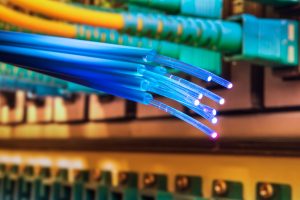Fiber Optic Cable Types
At SelectROW, we partner with municipalities and internet service providers (ISPs) interested in improving their telecommunications infrastructure to facilitate access to the latest technology. Fiber optic internet is one of the latest and most significant advancements in telecommunications technology.
In a fiber optic connection, a signal travels through a fiber cable. There are two common types of fiber optic cables — multimode and single-mode cables. On this page, we’ll discuss how fiber optic internet works and clarify the differences between the two types of cables.
Fiber Basics: Transmitting Signals With Light
Fiber optic transmission sends signals using light. This new form of wired broadband transmission replaces traditional copper wire transmission, which relied on electrical impulses.
A fiber optic cable is a bundle of fiberglass surrounded by reflective cladding. The cable connects to a signal source that emits light pulses. These pulses communicate information to the receiver through a binary code of ones and zeros. The light turning on indicates a one, whereas the light turning off indicates a zero. The receiver, or optical network terminal, deciphers the ones and zeros and converts them into electrical signals.
The glass and reflective cladding amplify and contain the light pulses as they travel through the cable. However, the light will eventually weaken and need regeneration. The strongest fiber optic cables can transmit a signal for 60 miles before regeneration.
Benefits of Fiber Optic Internet
Fiber optic internet offers numerous advantages that enhance connectivity for the end user:
- Fast download speeds: Fiber optic cables boost internet speeds to a maximum of 1,000 megabits per second, far faster than old technology.
- Matching upload speeds: Download speeds were previously twice as fast as upload speeds on average, but fiber optic connections boost matching speeds.
- Reliable connection: Fiber optic cables ensure a strong connection over great distances, even during peak use.
- Durability: Fiber optic cables are stronger than copper cables, reducing the likelihood of outages from damage.
Navigating the Last Mile
There are three primary ways to deliver fiber optic internet from the ISP to end users. These take fiber optic internet across the last mile in ways that maximize access and bandwidth while minimizing costs:
- Fiber to the premises (FTTP): The fiber cable runs directly to the user without copper wiring. FTTP connections are not available in all areas.
- Fiber to the neighborhood (FTTN): The fiber cable runs to a centralized location in a neighborhood. Copper cables distribute an internet connection to each building.
- Fiber to the building (FTTB): The fiber cable runs to each building. The buildings have independent distribution points that send the signal to the offices or apartments inside.
Fiber Optic Cable Types
Fiber optic cables come in two common varieties — multimode fiber cables and single-mode fiber cables. The two types of cables vary by the number of modes, or rays of light, that transmit through the fiber at a time.
Multimode Fiber
Multimode fiber cables carry more than one ray at a time.
For these cables to carry multiple rays, they must be relatively large in diameter. Multimode fiber cables come in two sizes — 50 micrometers and 62.5 micrometers. The cladding brings the cable’s diameter up to 125 micrometers.
The light used in multimode cables comes from either light-emitting diodes (LEDs) or vertical-cavity surface-emitting lasers (VCSELs). LEDs and VCSELs use two standard wavelengths — 850 micrometers and 1,300 micrometers.
The diameter of a multimode cable allows each ray to follow a unique path through the core. Taking unique paths results in the light reaching the end of the fiber at different times, which limits distance and capacity. However, LEDs and VCELs are cost-effective light producers.
Single-Mode Fiber
A single-mode fiber carries one ray at a time.
Because the laser sends a single type of light, the cable only needs to include room for a single pathway. As a result, single-mode fiber cables come in one core diameter — 9 micrometers. The cable’s final diameter is still the same 125 micrometers after cladding.
The ray, which is either 1,310 nanometers or 1,550 nanometers, emits from a laser. Sending a longer wave through a single channel allows single-mode fiber cables to provide rapid transmission speeds at great distances.
Multimode Fiber Vs. Single-Mode Fiber
Multimode and single-mode fiber cables have a few similarities. For instance, both transfer light through a fiber core, and each cable type has a final diameter of 125 micrometers. However, transmitting one wave versus multiple waves results in a few differences in structure and performance. Multimode and single-mode fiber cables vary in the following ways.
Distance
The smaller core allows single-mode cables to offer high speeds at greater distances than multimode cables. A multimode cable’s large diameter increases attenuation, meaning the signal requires regeneration more frequently. Frequent regeneration reduces the signal’s speed as the distance increases. Multimode cables can provide fast speeds at short distances, but single-mode cables are ideal for greater distances.
Bandwidth
Single-mode cables offer the greatest bandwidth compared to other options. The bandwidth improvement comes from the use of a single wave from a power source running through a small channel. The signal retains its clarity during transmission, even at great distances. Sending multiple signals through a wide channel can lead to distortion.
Cost
Single-mode cables cost the least to produce and install, but multimode cables cost less to use. While the smaller core size of a single-mode cable facilitates cost-effective manufacturing, the technology that generates the light is more expensive. Lasers are powerful but intricate, so they cost more to build than LEDs or VCSELs. Ultimately, single-mode cables are worth the expenses when installing them for long-distance transmission. Multimode cables are more affordable when transmitting over short distances.
How Can SelectROW Help With Fiber Cable Installation?
SelectROW has experience facilitating FRRB installations in numerous residential and commercial settings. Our skilled representatives will obtain the permits and approvals your organization needs to complete fiber installations. We also offer project management services that streamline tasks and reduce risk. For more information on our services, please call 888-997-3532 or submit an online contact form to receive a quote.

